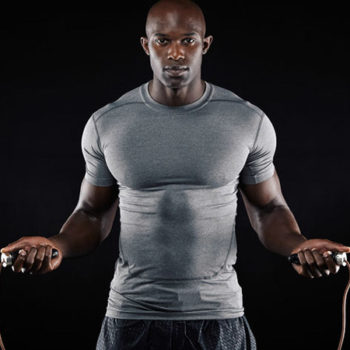What is The Best Heart Rate to Burn Fat?

You’ve decided that you want to lose some weight and start the fat burning process but are unsure how hard you need to work. Is interval training the way forward or will a daily walk out with the dog do the trick?
With an endless amount of training regimes, programs and transformations available, sometimes it can be difficult to know exactly where to start.
In this article we’ll break down how to use heart rate training zones to maximize your results and get the body you are after.
Here’s what we’ll cover:
- What is heart rate training?
- How do you work out what your heart rate needs to be?
- Training zones for optimal fat burning
Heart Rate and Fat Burning
Your body is constantly burning fat for as energy. As you are sat there reading this you are primarily using fat to power your body. It does this hour upon hour, minute upon minute. Great, so you should just lose weight normally then?
Well, no. The problem is that at rest, you just aren’t burning enough overall to make a difference, regardless of how many comes from fat. To burn sufficient amounts to make a difference, you need to burn off more energy each day than you put in your body – this is referred to as a negative energy balance or calorie deficit.
As we know quite clearly, the more active you are the more calories you burn. That makes sense – by being more active you’ll use more energy than at rest, and this in turn will help you reach your energy deficit. That part is simple physics.
The American College of Sports Medicine (ACSM) recommend that in order to lose weight and improve body composition, you should exercise for 200-300 minutes and aim to burn around 2000 kcal per week. This equates to being active every day for a minimum of 30 minutes or more [1].
So it makes sense that if you want to lose weight or burn fat you need to be more active. Combine this with a controlled diet and you’re well on your way. As soon as you start hitting a negative energy balance on a daily basis you’ll start to see some progress.
But does that mean you have to work as hard as possible to try and burn the most amount of energy you can? Is less more? Or is there a ‘sweet spot’ that you need to aim for? To answer these questions we need to look at the science of fat burning…
Fat Burning Science
Our body uses food for energy. In particular it uses carbohydrates and fats as primary fuel sources dependant on how hard your body is working at any one point in time, and to a much lesser extent also uses protein.
Very early scientific studies by Romijn [2] found that working at a heart rate of around 65% of MHR maximized the amount of calories that were burned from fat, with less being burned from carbs. As intensity increased, above this 65% threshold, Romijn found that less fat was burned and more carbs were used.
And that kicked off the premise of a ‘fat burning zone’ that was popular for around 20 or so years. If you wanted to lose weight then you’d work at only a moderate intensity.
Since then, science shows us that that threshold is as high as 80% of your maximum heart rate. In fact, a recent study found that whilst there was a high levels of variability between subjects, the precise maximal heart rate zone for fat oxidation was between 60.2% and 80% – working out at 3.11 kcal per minute being burned from fat [3].
Energy in the fat burning zone is provided aerobically, which means that oxygen is used and energy transfer takes place within a specialized part of the cell called a mitochondria. Because the intensity is low, your body doesn’t need to break down stored energy that quickly, so by entering the mitochondria it gains a significant amount of usable energy in a slow and controlled manner – this comes from fats. It’s a little bit like emptying a water bottle by letting it trickle – you get water slowly but for a long period of time.
But once you exercise above this level – classed as higher intensity – you start to burn more carbs and less fat as a relative amount. The reason why is that you need energy quickly – so by using more carbs and staying out of the mitochondria you get less energy overall, but get it quicker.
More and more you’ll rely less on aerobic energy production and use more and more on carbs via anaerobic energy production – this doesn’t use oxygen and takes places outside of the mitochondria. The only downside is you get tired quicker as you soon run out of stored carbs and therefore energy – this is a bit like turning the bottle of water upside down and letting the water spurt out. You get fast energy, but it won’t last long before it runs out.
So Avoid Higher Intensity Exercise?
Not at all.
At very high intensities, you’ll burn a minimum amount of fat as an overall percentage, with most of the energy coming from glycogen (carbs). So by that rationale, you wouldn’t want to work over 80% MHR as you wouldn’t burn as much fat.
But that’s not strictly true.
Interval training is a popular method of training where you spend short periods of time working at high intensity – as high as 90-100% MHR, followed by periods of recovery at low heart rates.
Firstly, the overall amount of calories you burn at high intensities is much, much higher – research show for example that you’ll burn around 14 kcal per minute during modified Tabata intervals – and around 240-360 kcal in 20 minutes [4].
Although you might be using less fat as a percentage, the fact that you are burning a higher total calories often means you’ll burn just as many fat calories, if not more when you add up the total energy burned in the workout.
Secondly, intervals will drastically improve fitness levels too – more so than training in the fat burning zone. Ans this improvement in fitness makes you much more efficient at burning fat in the long run.
And if this isn’t enough for you to consider giving intervals a go for fat loss then consider this – working at higher intensities also increases the amount of calories you burn after exercise, not just during. This is a process called excess post-exercise oxygen consumption (EPOC), or the afterburn effect for short.
Studies show that when you exercise at a moderate intensity below 80% you might burn more calories from fat during exercise, but your metabolism very quickly returns to normal [5]. Work above 80% though and you’ll continue to burn calories for over 10 hours – and it’s this effect that can really boost fat loss.
So What Does This All Mean – Fat Burning or High Intensity?
Basically, you can burn fat at both moderate and high intensities – you just need to work out which is best for you.
If you want to burn fat and you are a beginner, you should aim for a heart rate of between 65-80% MHR when you work out. Starting slow and gradually increasing the intensity over time allows your body time to adapt. And as much as interval training is beneficial, exercise at high intensity for those without a base of fitness can be unhealthy and potentially unsafe.
Once your heart, lungs and muscles become accustomed to working between 60% and 80% you can introduce interval training to further push your fat loss progress. And this is what you should ultimately be aiming for.
For those who are more advanced and want to burn fat, you need to view fat burning as a broad scale rather than an on-off switch that lies around 80% MHR. Just because you’re working hard doesn’t mean you won’t burn fat – if anything the increase in workload and total calorie burn means you’ll improve body composition just as well if not better.
How to Work out Your Maximum Heart Rate
This would be a pretty pointless article if you went away knowing what training zones to work in but not being able to calculate them. Although there’s a small amount of maths involved here, it’s quite a simple process and well worth persevering with.
There are a few different ways to work out your maximum heart rate (MHR) but the simplest is to minus your age from 220. For example if you were 27 years old your MHR would be 193 beats per minute (220 – 27 = 193). It’s as simple as that.
Whilst it’s only a guide, it’s the most recognised method and is usually pretty accurate.
The next stage is to work out the different percentages. So for example, if you wanted to work at 60% of your maximum you’d take your MHR and multiply it by 0.6. If you wanted to work out 85% you’d times it by 0.85 and so on. If we take our 27 year old as an example:
- 193 x 0.6 = 116 beats per minute (60% of MHR)
- 193 x 0.85 = 164 beats per minute (85% of MHR)
From there you can create specific zones to suit your needs. With the example above, the exerciser would train between 116 and 164 beats per minute to optimize fat loss as a beginner, and above 164 if they were more advanced.



